Abstract
Understanding the extent to which childhood leukaemia and non-Hodgkin lymphomas are heritable is important to the survivors of these diseases, their families and clinicians who provide genetic counselling. Such understanding is also relevant to the possibility raised by Gardner et al. (1990, Br. Med. J., 300, 423-429) that paternal preconception irradiation may be an aetiological factor in these diseases. No malignant neoplasm was diagnosed among 382 offspring of survivors of childhood leukaemia and non-Hodgkin lymphoma followed up for a median period of 5.8 years, the largest available cohort of such offspring. These data indicate that it is unlikely that the risk of a malignant neoplasm occurring in the offspring exceeds eight times that expected in the general population. Similarly, the risk of leukaemia and non-Hodgkin lymphoma among offspring is unlikely to exceed 21 times that expected. The proportion of survivors of childhood leukaemia and non-Hodgkin lymphoma with the heritable form of these diseases is unlikely to exceed 5%, assuming an autosomal dominant pattern of transmission, with penetrance of at least 70% and that all heritable cases develop by age 15 years. The best (i.e. at present most likely) estimates of these risks are of course much lower. There was no evidence of an excess of congenital abnormalities among the offspring and the sex ratio was similar to that expected from the general population.
Full text
PDF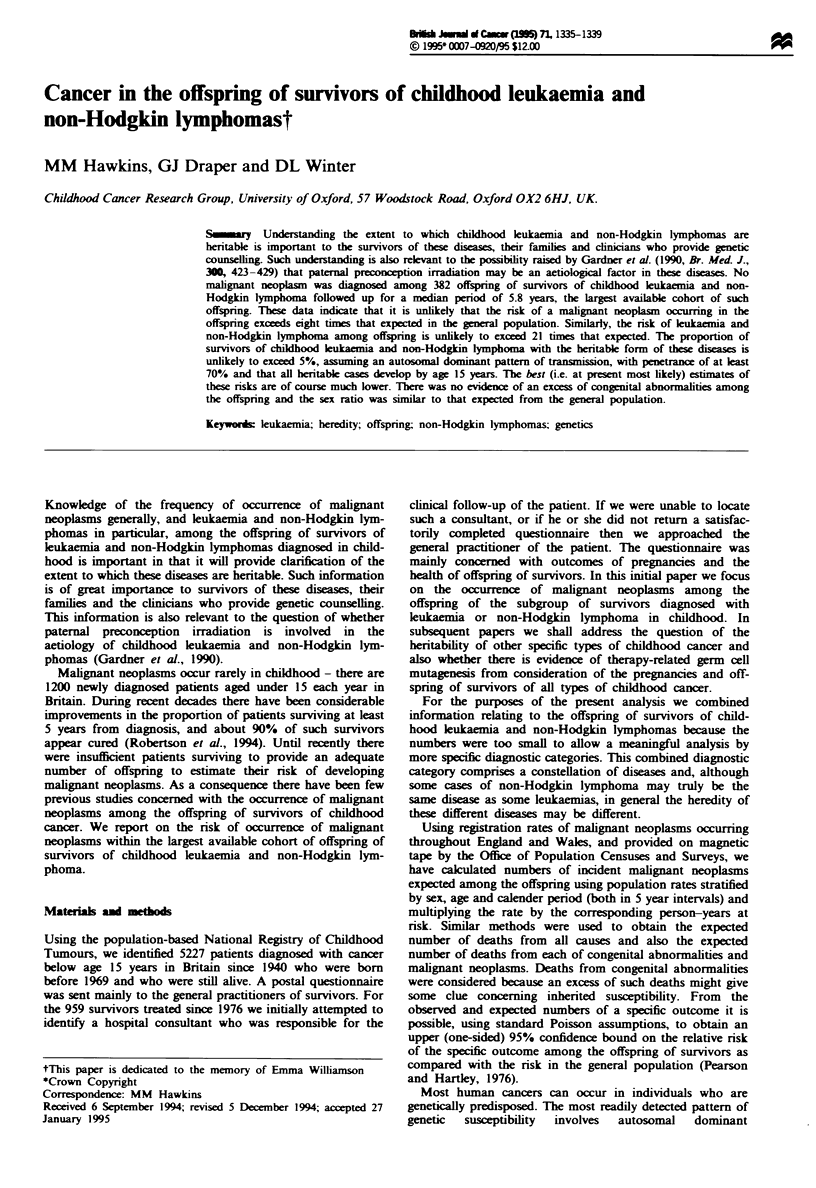
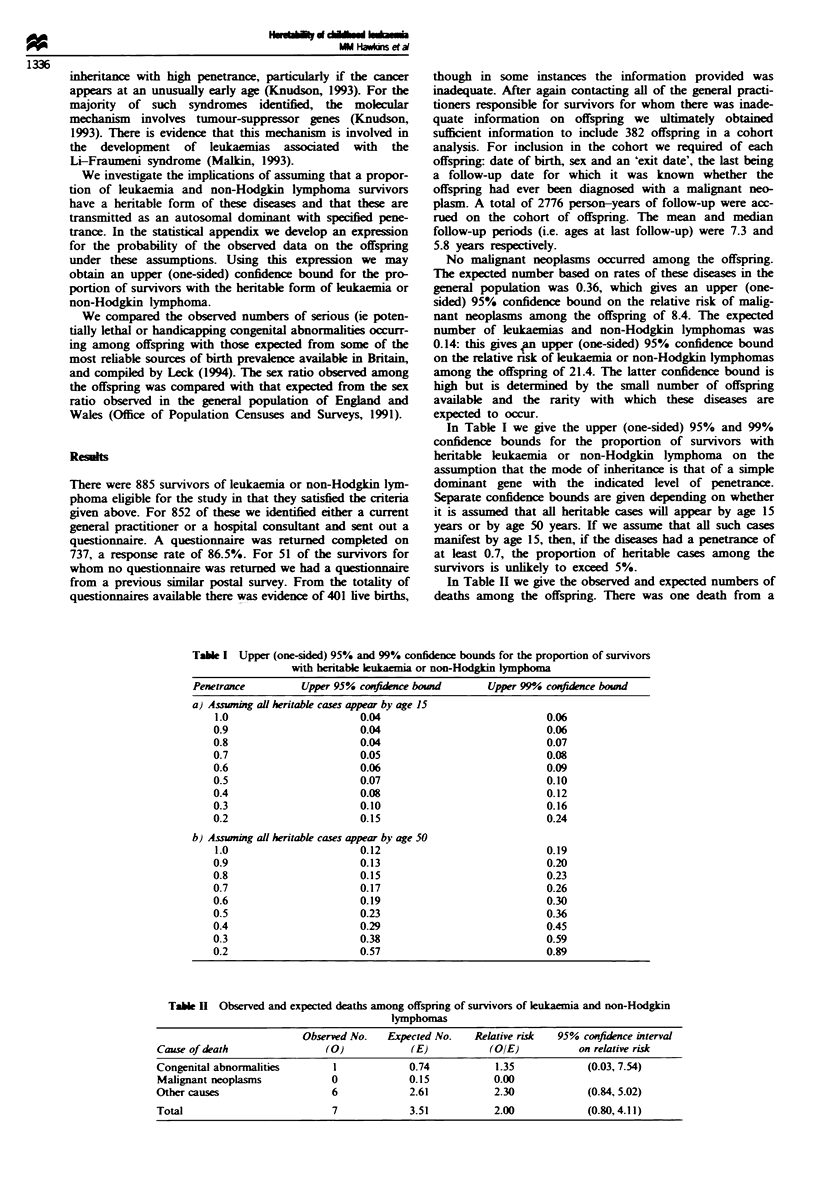
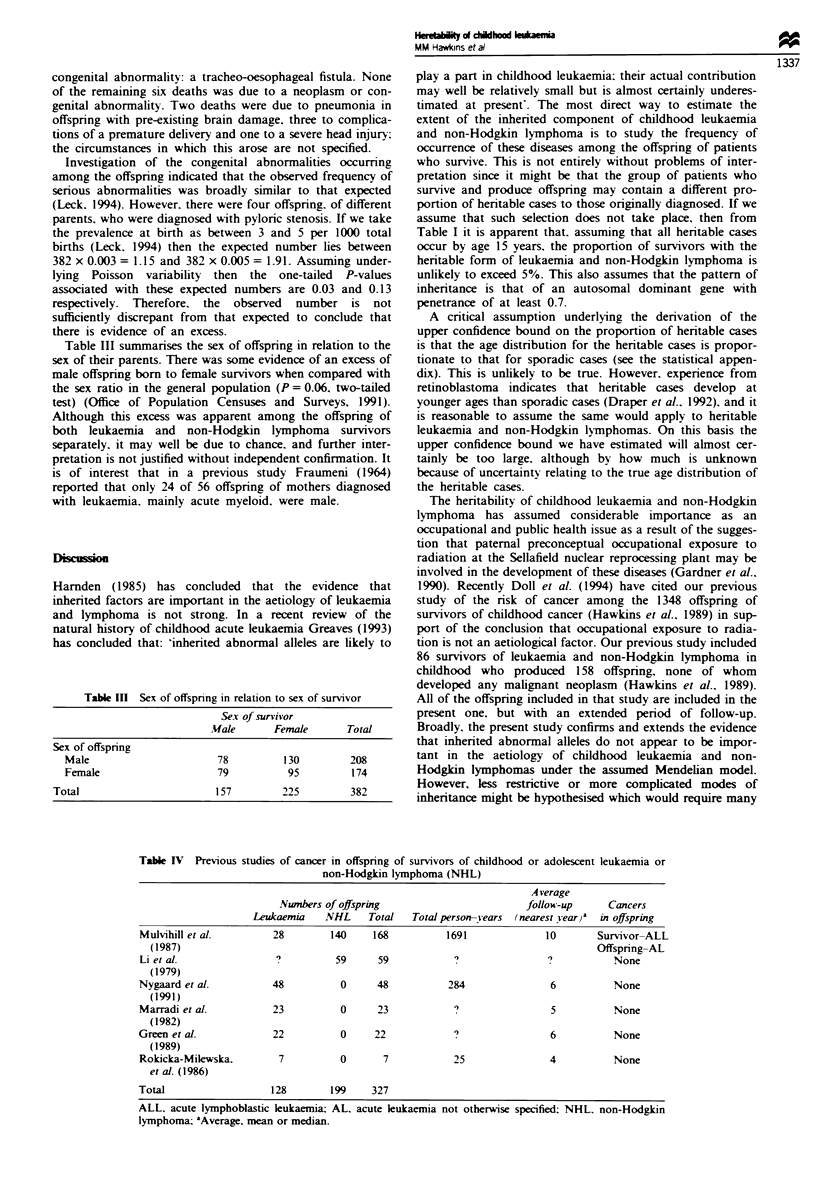
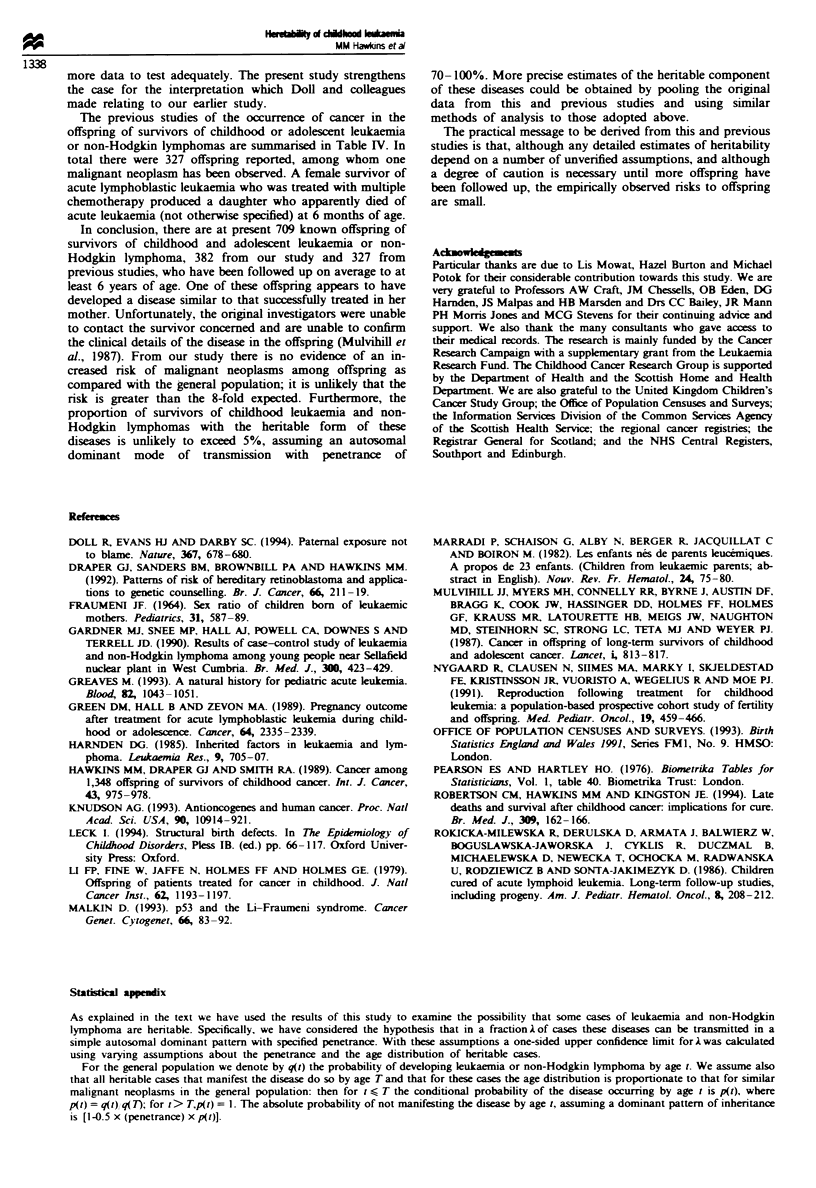
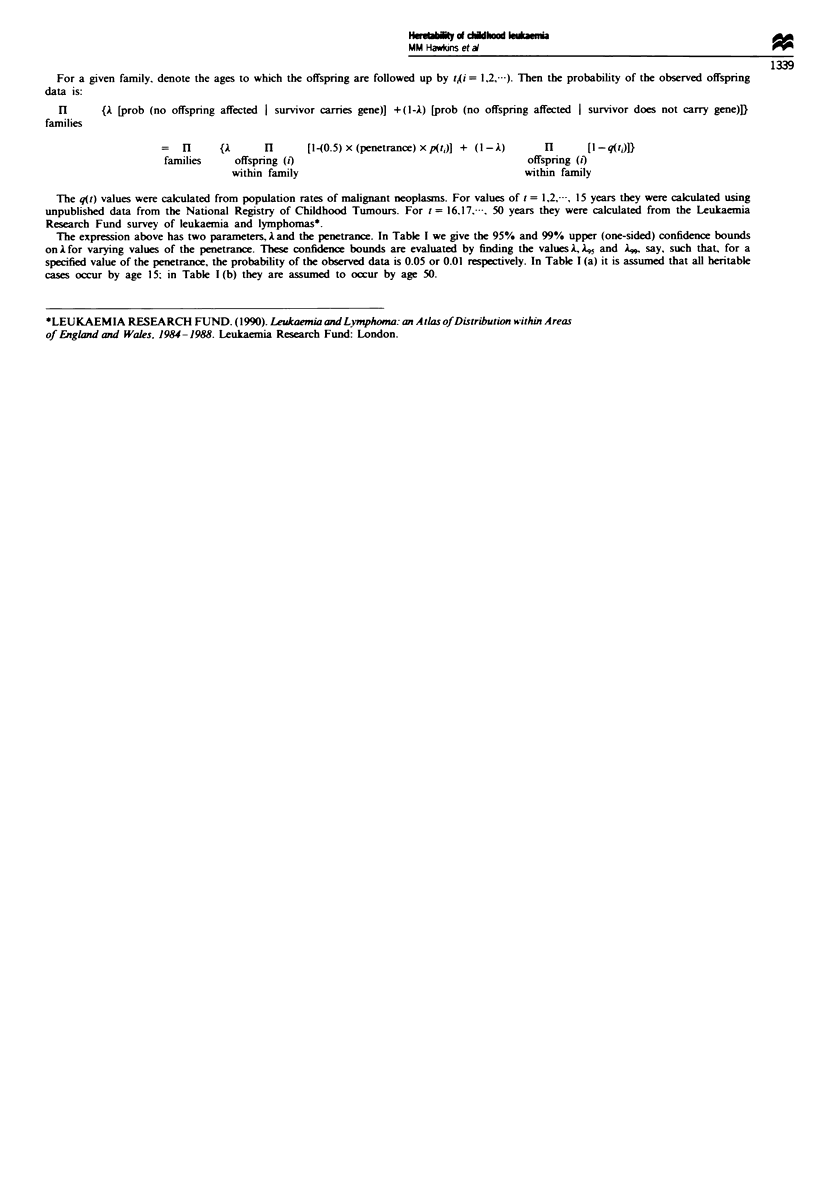
Selected References
These references are in PubMed. This may not be the complete list of references from this article.
- Doll R., Evans H. J., Darby S. C. Paternal exposure not to blame. Nature. 1994 Feb 24;367(6465):678–680. doi: 10.1038/367678a0. [DOI] [PubMed] [Google Scholar]
- Draper G. J., Sanders B. M., Brownbill P. A., Hawkins M. M. Patterns of risk of hereditary retinoblastoma and applications to genetic counselling. Br J Cancer. 1992 Jul;66(1):211–219. doi: 10.1038/bjc.1992.244. [DOI] [PMC free article] [PubMed] [Google Scholar]
- FRAUMENI J. F., Jr SEX RATIO OF CHILDREN BORN OF LEUKEMIC MOTHERS. Pediatrics. 1964 Apr;33:587–589. [PubMed] [Google Scholar]
- Gardner M. J., Snee M. P., Hall A. J., Powell C. A., Downes S., Terrell J. D. Results of case-control study of leukaemia and lymphoma among young people near Sellafield nuclear plant in West Cumbria. BMJ. 1990 Feb 17;300(6722):423–429. doi: 10.1136/bmj.300.6722.423. [DOI] [PMC free article] [PubMed] [Google Scholar]
- Greaves M. A natural history for pediatric acute leukemia. Blood. 1993 Aug 15;82(4):1043–1051. [PubMed] [Google Scholar]
- Green D. M., Hall B., Zevon M. A. Pregnancy outcome after treatment for acute lymphoblastic leukemia during childhood or adolescence. Cancer. 1989 Dec 1;64(11):2335–2339. doi: 10.1002/1097-0142(19891201)64:11<2335::aid-cncr2820641124>3.0.co;2-7. [DOI] [PubMed] [Google Scholar]
- Harnden D. G. Inherited factors in leukaemia and lymphoma. Leuk Res. 1985;9(6):705–707. doi: 10.1016/0145-2126(85)90279-6. [DOI] [PubMed] [Google Scholar]
- Hawkins M. M., Draper G. J., Smith R. A. Cancer among 1,348 offspring of survivors of childhood cancer. Int J Cancer. 1989 Jun 15;43(6):975–978. doi: 10.1002/ijc.2910430604. [DOI] [PubMed] [Google Scholar]
- Knudson A. G. Antioncogenes and human cancer. Proc Natl Acad Sci U S A. 1993 Dec 1;90(23):10914–10921. doi: 10.1073/pnas.90.23.10914. [DOI] [PMC free article] [PubMed] [Google Scholar]
- Li F. P., Fine W., Jaffe N., Holmes G. E., Holmes F. F. Offspring of patients treated for cancer in childhood. J Natl Cancer Inst. 1979 May;62(5):1193–1197. [PubMed] [Google Scholar]
- Malkin D. p53 and the Li-Fraumeni syndrome. Cancer Genet Cytogenet. 1993 Apr;66(2):83–92. doi: 10.1016/0165-4608(93)90233-c. [DOI] [PubMed] [Google Scholar]
- Marradi P., Schaison G., Alby N., Berger R., Jacquillat C., Boiron M. Les enfants nés de parents leucémiques. A propos de 23 enfants. Nouv Rev Fr Hematol. 1982;24(2):75–80. [PubMed] [Google Scholar]
- Mulvihill J. J., Myers M. H., Connelly R. R., Byrne J., Austin D. F., Bragg K., Cook J. W., Hassinger D. D., Holmes F. F., Holmes G. F. Cancer in offspring of long-term survivors of childhood and adolescent cancer. Lancet. 1987 Oct 10;2(8563):813–817. doi: 10.1016/s0140-6736(87)91012-9. [DOI] [PubMed] [Google Scholar]
- Nygaard R., Clausen N., Siimes M. A., Márky I., Skjeldestad F. E., Kristinsson J. R., Vuoristo A., Wegelius R., Moe P. J. Reproduction following treatment for childhood leukemia: a population-based prospective cohort study of fertility and offspring. Med Pediatr Oncol. 1991;19(6):459–466. doi: 10.1002/mpo.2950190603. [DOI] [PubMed] [Google Scholar]
- Robertson C. M., Hawkins M. M., Kingston J. E. Late deaths and survival after childhood cancer: implications for cure. BMJ. 1994 Jul 16;309(6948):162–166. doi: 10.1136/bmj.309.6948.162. [DOI] [PMC free article] [PubMed] [Google Scholar]
- Rokicka-Milewska R., Derulska D., Armata J., Balwierz W., Boguslawska-Jaworska J., Cyklis R., Duczmal B., Michalewska D., Newecka T., Ochocka M. Children cured of acute lymphoid leukemia. Long-term follow-up studies, including progeny. Am J Pediatr Hematol Oncol. 1986 Fall;8(3):208–212. doi: 10.1097/00043426-198623000-00006. [DOI] [PubMed] [Google Scholar]


